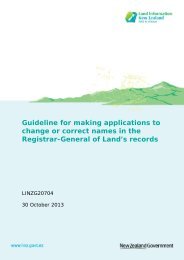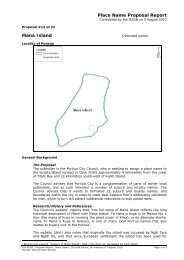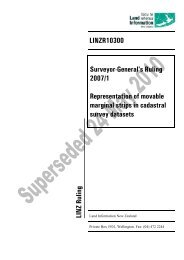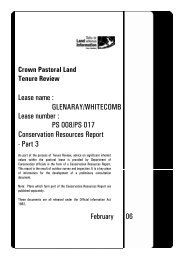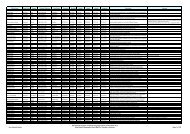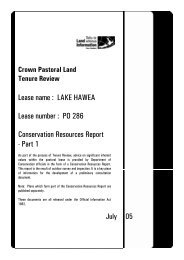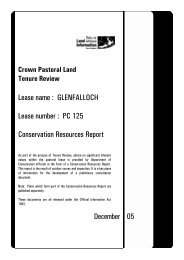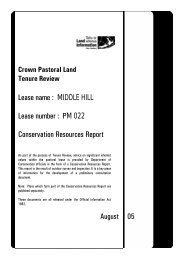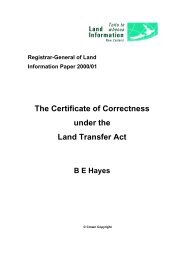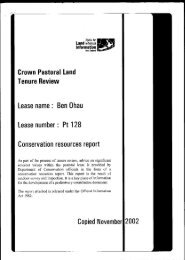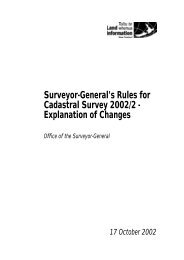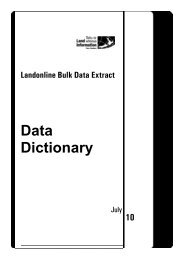Part 1 - Land Information New Zealand
Part 1 - Land Information New Zealand
Part 1 - Land Information New Zealand
Create successful ePaper yourself
Turn your PDF publications into a flip-book with our unique Google optimized e-Paper software.
RELEASED UNDER THE OFFICIAL INFORMATION ACT<br />
2.5.1 Significance of Vegetation<br />
The PL contains representation of the plants and plant communities in the montane, sub-alpine,<br />
and low alpine bioclimatic zones of the Pisa ED and Meg, Lowburn and Canine <strong>Land</strong> Systems.<br />
Two RAPs lie in part within the PL.<br />
At least 207 native vascular plant species (Attachment 4.5) are present, representing<br />
approximately 61 % of the indigenous vascular plant diversity recorded during the PNA survey of<br />
the much larger (84750 ha) and ecologically diverse Pisa ED.<br />
Threatened and At Risk species<br />
Of the native vascular plant species present, five are listed as ‘Threatened’ and 14 as ‘At Risk’ in<br />
the most recent threat classification system listing (de Lange et al. 2009). A list of these species<br />
with their threat of extinction status and distribution within the PL is provided below in Table 2.<br />
The <strong>New</strong> <strong>Zealand</strong> Threat Classification System provides a tool for assigning a threat status to<br />
candidate taxa. Species listed in the super category ‘Threatened” are grouped into three<br />
categories: ‘Nationally Critical’, Nationally Endangered’, and ‘Nationally Vulnerable’. Taxa in<br />
these three categories are facing a very high risk of extinction in the wild.<br />
The latest revision (Townsend et al. 2008) of the 2002 system includes the addition of the new<br />
categories ‘Declining’, ‘Naturally Uncommon’, ‘Recovering’ and ‘Relict’ within a super category<br />
‘At Risk’. Declining taxa do not qualify as ‘Threatened’ because they are buffered by a large total<br />
population size and/or slower decline rate. However, if the declining trends continue, these taxa<br />
may be listed as ‘Threatened’ in the future. The category ‘Naturally Uncommon’ is adopted to<br />
distinguish between biologically scarce and threatened taxa. ‘Recovering’ allows for threatened<br />
taxa whose status is improving through management action and ‘Relict’ is used to encompass taxa<br />
that have experienced very large historic range reductions and now exist as remnant populations<br />
that are not considered unduly threatened.<br />
12



